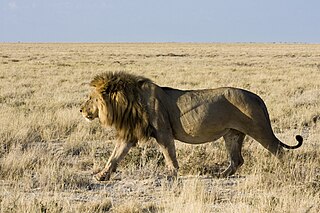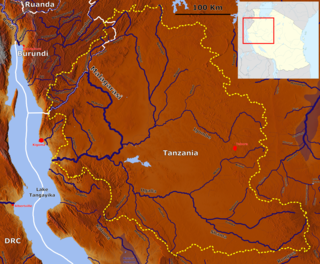Ethnic group from Rukwa Region of Tanzania
The Rungwa are an ethnic and linguistic group based in the Mpanda District of Rukwa Region in western Tanzania. In 1987 the Rungwa population was estimated to number 18,000 .
The Rungwa are an ethnic and linguistic group based in the Mpanda District of Rukwa Region in western Tanzania. In 1987 the Rungwa population was estimated to number 18,000 .

The greater kudu is a large woodland antelope, found throughout eastern and southern Africa. Despite occupying such widespread territory, they are sparsely populated in most areas due to declining habitat, deforestation, and poaching. The greater kudu is one of two species commonly known as kudu, the other being the lesser kudu, T. imberbis.

Singida Region is one of Tanzania's 31 administrative regions. The region covers a land area of 49,340 km2 (19,050 sq mi). The region is comparable in size to the combined land area of the nation state of Slovakia. The Region is bordered to the north by Shinyanga Region, Simiyu Region and Arusha Region, to the northeast by Manyara Region, to the east by Dodoma Region, to the southeast by Iringa Region, to the southwest by Mbeya Region and to the west by Tabora Region. The regional capital is the municipality of Singida. According to the 2012 national census, the region had a population of 1,370,637.

Mbeya Region is one of Tanzania's 31 administrative regions. The region covers an area of 35,954 km2 (13,882 sq mi). The region is comparable in size to the combined land area of the nation state of Guinea Bissau. Mbeya Region is bordered to the east by Singida Region, Iringa Region and Njombe Region. The region is bordered to the south by Malawi and Lake Nyasa. To the north the region borders southern Tabora Region. Lastly, Mbeya is bordered to the west by Songwe Region. The regional capital is the city of Mbeya. According to the 2012 national census, the region had a population of 2,707,410.

Manyoni District is one of the six districts in the Singida Region of Tanzania. The district capital is the town of Manyoni. The district is bordered to the north by the Ikungi District, to the east by the Dodoma Region, to the south by the Iringa Region, to the southwest by the Mbeya Region and to the west by the Tabora Region. In 2015 the Itigi District was created from the Manyoni District, separating the Itigi Division that was the large portion of the south western of the district.

Panthera leo melanochaita is a lion subspecies in Southern and East Africa. In this part of Africa, lion populations are not regionally extinct in Lesotho, Djibouti and Eritrea, and are threatened by loss of habitat and prey base, killing by local people in retaliation for loss of livestock, and in several countries also by trophy hunting. Since the turn of the 21st century, lion populations in intensively managed protected areas in Botswana, Namibia, South Africa and Zimbabwe have increased, but declined in East African range countries. In 2005, a Lion Conservation Strategy was developed for East and Southern Africa.

The 250 or so "Narrow Bantu languages" are conventionally divided up into geographic zones first proposed by Malcolm Guthrie (1967–1971). These were assigned letters A–S and divided into decades ; individual languages were assigned unit numbers, and dialects further subdivided. This coding system has become the standard for identifying Bantu languages; it was the only practical way to distinguish many ambiguously named languages before the introduction of ISO 639-3 coding, and it continues to be widely used. Only Guthrie's Zone S is (sometimes) considered to be a genealogical group. Since Guthrie's time a Zone J has been set up as another possible genealogical group bordering the Great Lakes.

The Malagarasi River is a river in western Tanzania, flowing through Kigoma Region, although one of its tributaries comes from southeastern Burundi. The river also forms the western border of Tabora Region, the southern border of Kagera Region and the southwestern border of Geita Region. It is the second-longest river in Tanzania behind the Rufiji—Great Ruaha, and has the largest watershed of any river flowing into Lake Tanganyika. The Malagarasi-Muyovozi Wetlands are a designated a Ramsar site. Local tribes have nicknamed the Malagarasi as "the river of bad spirits".
Rungwa is an administrative ward in the Manyoni District of the Singida Region of Tanzania. In 2016 the Tanzania National Bureau of Statistics report there were 2,424 people in the ward, from 2,209 in 2012.
The Rungwa Game Reserve is a protected area in Tanzania that covers an area of 9,000 km2 (3,500 sq mi). It was established in 1951. It is situated in Itigi District, Singida Region.
The Rukwa languages are a group of Bantu languages established by Nurse (1988) and Fourshey (2002). They constitute half of Guthrie's Zone M, plus Bungu. The languages, or clusters, along with their Guthrie identifications, are:
Rungwa is a Bantu language of the Rukwa Region of western Tanzania.

Katavi Region is one of Tanzania's 31 administrative regions. The region covers an area of 45,843 km2 (17,700 sq mi). The region is comparable in size to the combined land area of the nation state of Estonia. Kagera Region is bordered to the east by Tabora Region. The region is bordered to the south by Rukwa Region and Songwe Region. Lastly, Katavi borders DRC on Lake Tanganyika to the west. The region derives its name from Katavi, the spirit of lake Tanganyika. The regional capital city is Mpanda. According to the 2012 national census, the region had a population of 564,604.
RNW or rnw may refer to:
The Ufipa Plateau is a highland in southwestern Tanzania. It lies mostly in Rukwa Region, near the border with Zambia. The plateau is named for the Fipa people who inhabit it.

Itigi District is a district council in the Singida Region of central Tanzania established in 2015. The district lies in the south-western portion of the Singida Region with 123,515 people and encompasses a large area mostly made up of protected game reserves.